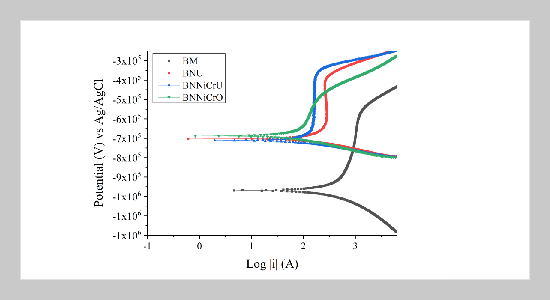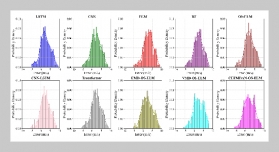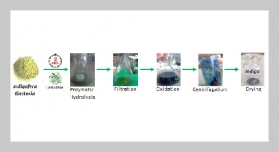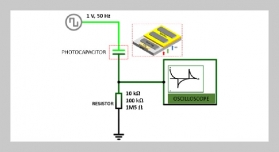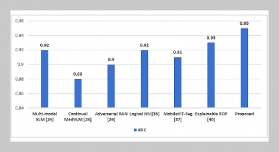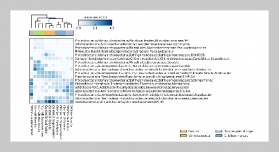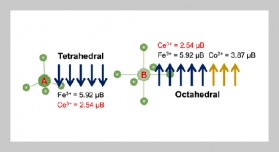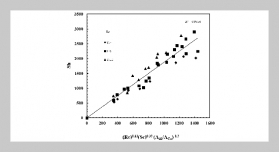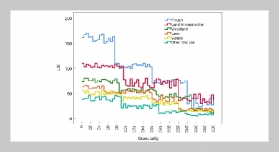- [1] V. Vukojevi´c, A. Sedmak, S. Jovi´c, B. Nedeljkovi´c, and I. Blaˇci´c, (2018) “The Effect of Vanadium Content on Microstructure and Impact Toughness of Forged High Alloy Steel X96CrMo12-1" International Journal of Metalcasting 13(1): 82–88. DOI: 10.1007/s40962-018-0225-4.
- [2] M. A. Korchuganov, A. V. Filippov, S. Y. Tarasov, O. A. Podgornyh, N. N. Shamarin, and E. O. Filippova. “An experimental modeling and acoustic emission monitoring of abrasive wear in a steel/diabase pair”. In: AIP Conference Proceedings. Author(s), 2016. DOI: 10.1063/1.4966395.
- [3] D. T. Tanasache, D. Dinica, E. F. Binchiciu, and H. Binchiciu, (2018) “Equal Resistant to Wear Blades Used in Rough Exploitation Conditions" Advanced Materials Research 1146: 22–26. DOI: 10.4028/www.scientific.net/amr.1146.22.
- [4] L. Widder, M. Varga, K. Adam, and A. Kuttner, (2017) “Development of Impact Energy Distribution of Various Abrasives during Cyclic Impact/Abrasion Testing" Solid State Phenomena 267: 234–242. DOI: 10.4028/www.scientific.net/ssp.267.234.
- [5] S. Singla, A. S. Kang, J. S. Grewal, and G. S. Cheema, (2014) “Wear Behavior of Weld Overlays on Excavator Bucket Teeth" Procedia Materials Science 5: 256–266. DOI: 10.1016/j.mspro.2014.07.265.
- [6] A. Kele¸s and M. Yildirim, (2020) “Improvement of mechanical properties by means of titanium alloying to steel teeth used in the excavator" Engineering Science and Technology, an International Journal 23(5): 1208– 1213. DOI: 10.1016/j.jestch.2019.12.003.
- [7] S. H. Suryo, S. A. Widyanto, P. Paryanto, and A. S. Mansuri, (2018) “Hardness Optimization of Heat Treatment Process of Bucket Teeth Excavator" Civil Engineering Journal 4(2): 294. DOI: 10.28991/cej-030992.
- [8] S. Atakhanova, U. Kasimov, R. Karimov, and B. Khasanov, (2021) “Improving the wear resistance of mining excavator":
- [9] Y. Purwaningrum, M. Hafiz, and R. Suparyanto, (2020) “Analysis of Physical and Mechanical Properties of Backhoe’s Bucket Repairment with Cladding Methode" Key Engineering Materials 841: 254–258.
- [10] V. Gromov, S. Raykov, V. Kormyshev, D. Kosinov, O. Kondratova, and D. Romanov. “Physical and technical fundamentals of technology used to increase the wear resistance of working surfaces of large volume excavator buckets”. In: IOP Conference Series: Earth and Environmental Science. 206. 1. IOP Publishing. 2018, 012029.
- [11] H. Zhao, (2022) “Effect Of Magnesium Alloy Surface Spray Coating On The Wear Resistance Of Sports Equipment" Journal of Applied Science and Engineering 26: 423–432. DOI: 10.6180/jase.202303_26(3).0013.
- [12] J. Mehta, V. K. Mittal, and P. Gupta, (2017) “Role of Thermal Spray Coatings on Wear, Erosion and Corrosion Behavior: A Review" Journal of Applied Science and Engineering 20: 445–452. DOI: 10.6180/jase.2017.20.4.05.
- [13] B. Cheniti, D. Miroud, P. Hvizdoš, J. Balko, R. Sedlák, T. Csanádi, B. Belkessa, and M. Fides, (2018) “Investigation of WC decarburization effect on the microstructure and wear behavior of WC-Ni hardfacing under dry and alkaline wet conditions" Materials Chemistry and Physics 208: 237–247. DOI: 10.1016/j.matchemphys.2018.01.052.
- [14] A. C. Crespo, A. Scotti, and M. R. Pérez, (2008) “Operational behavior assesment of coated tubular electrodes for SMAW hardfacing" Journal of Materials Processing Technology 199(1-3): 265–273. DOI: 10.1016/j.jmatprotec.2007.07.048.
- [15] A. Saha and S. C. Mondal, (2017) “Multi-objective optimization of manual metal arc welding process parameters for nano-structured hardfacing material using hybrid approach" Measurement 102: 80–89. DOI: 10.1016/j.measurement.2017.01.048.
- [16] V. Balasubramanian, R. Varahamoorthy, C. S. Ramachandran, and C. Muralidharan, (2008) “Selection of welding process for hardfacing on carbon steels based on quantitative and qualitative factors" The International Journal of Advanced Manufacturing Technology 40(9-10): 887–897. DOI: 10.1007/s00170-008-1406-8.
- [17] R. R. Garbade and N. B. Dhokey, (2021) “Overview on Hardfacing Processes, Materials and Applications" IOP Conference Series: Materials Science and Engineering 1017(1): 012033. DOI: 10.1088/1757899x/1017/1/012033.
- [18] R. Suraj, (2021) “Hardfacing and its effect on wear and corrossion performance of various ferrous welded mild steels" Materials Today: Proceedings 42: 842–850. DOI: 10.1016/j.matpr.2020.11.592.
- [19] J. J. Coronado, H. F. Caicedo, and A. L. Gómez, (2009) “The effects of welding processes on abrasive wear resistance for hardfacing deposits" Tribology International 42(5): 745–749. DOI: 10.1016/j.triboint.2008.10.012.
- [20] M. Kirchgaßner, E. Badisch, and F. Franek, (2008) “Behaviour of iron-based hardfacing alloys under abrasion and impact" Wear 265(5-6): 772–779. DOI: 10.1016/j.wear.2008.01.004.
- [21] S. Selvi, S. Sankaran, and R. Srivatsavan, (2008) “Comparative study of hardfacing of valve seat ring using MMAW process" Journal of Materials Processing Technology 207(1-3): 356–362. DOI: 10.1016/j.jmatprotec.2008.06.053.
- [22] R. A. Jeshvaghani, E. Harati, and M. Shamanian, (2011) “Effects of surface alloying on microstructure and wear behavior of ductile iron surface-modified with a nickel-based alloy using shielded metal arc welding" Materials & Design 32(3): 1531–1536. DOI: 10.1016/j.matdes.2010.10.006.
- [23] X. Ren, R. James, E. Brookes, and L. Wang, (2001) “Machining of high chromium hardfacing materials" Journal of Materials Processing Technology 115(3): 423–429. DOI: 10.1016/s0924-0136(01)01029-9.
- [24] M. Bahrololoom and A. Hoveidaei, (1999) “Influence of post-heat treatment and complexing agents on hardness of Ni–Cr alloy coatings" Surface Engineering 15(6): 502–504. DOI: 10.1179/026708499101516830.
- [25] S. A. A. Dilawary, A. Motallebzadeh, E. Atar, and H. Cimenoglu, (2018) “Influence of Mo on the high temperature wear performance of NiCrBSi hardfacings" Tribology International 127: 288–295. DOI: 10.1016/j.triboint.2018.06.022.
- [26] A. Bhaduri, R. Indira, S. Albert, B. Rao, S. Jain, and S. Asokkumar, (2004) “Selection of hardfacing material for components of the Indian Prototype Fast Breeder Reactor" Journal of Nuclear Materials 334(2-3): 109–114. DOI: 10.1016/j.jnucmat.2004.05.005.
- [27] D. Persson, S. Jacobson, and S. Hogmark, (2003) “Effect of temperature on friction and galling of laser processed Norem 02 and Stellite 21" Wear 255(1-6): 498– 503. DOI: 10.1016/s0043-1648(03)00122-4.
- [28] S. Nath, S. Pityana, and J. D. Majumdar, (2012) “Laser surface alloying of aluminium with WCCoNiCr for improved wear resistance" Surface and Coatings Technology 206(15): 3333–3341. DOI: 10.1016/j.surfcoat.2012.01.038.
- [29] K. Chong, Y. Zou, D. Wu, Y. Tang, and Y. Zhang, (2021) “Pulsed laser remelting supersonic plasma sprayed Cr3C2-NiCr coatings for regulating microstructure, hardness and corrosion properties" Surface and Coatings Technology 418: 127258. DOI: 10.1016/j.surfcoat.2021.127258.
- [30] M. Zhong, W. Liu, and H. Zhang, (2006) “Corrosion and wear resistance characteristics of NiCr coating by laser alloying with powder feeding on grey iron liner" Wear 260(11-12): 1349–1355. DOI: 10.1016/j.wear.2005.09.033.
- [31] U. Ozdemir, M. Sozeri, T. Findik, and V. Kilicli, (2023) “Effect of buttering on the wear behavior of the SMA welded hardfacing layer in a low-carbon steel" Materials Testing 65(4): 494–504. DOI: 10.1515/mt-2022-0438.
- [32] N. Galchenko, S. Raskoshniy, B. Dampilon, and K. Kolesnikova. “Features of crystallization of welded seams from diverse materials at electron beam welding on the example of highly steel and copper”. In: AIP Publishing, 2019. DOI: 10.1063/1.5131977.
- [33] T. SIDHU, S. PRAKASH, and R. AGRAWAL, (2006) “Hot corrosion performance of a NiCr coated Ni-based alloy" Scripta Materialia 55(2): 179–182. DOI: 10.1016/j.scriptamat.2006.03.054.
- [34] G. J. Adetunji, R. G. Faulkner, and E. A. Little, (1991) “Quenching-rate determination for standard steel tensile specimens" Journal of Materials Science 26(7): 1847–1850. DOI: 10.1007/bf00543613.
- [35] P. Brito, P. A. Ramos, L. P. Resende, D. A. de Faria, and O. K. Ribas, (2019) “Experimental investigation of cooling behavior and residual stresses for quenching with vegetable oils at different bath temperatures" Journal of Cleaner Production 216: 230–238. DOI: 10.1016/j.jclepro.2019.01.194.
- [36] E. Albertin, F. Beneduce, M. Matsumoto, and I. Teixeira, (2011) “Optimizing heat treatment and wear resistance of high chromium cast irons using computational thermodynamics" Wear 271(9-10): 1813–1818. DOI: 10.1016/j.wear.2011.01.079.
- [37] V. Garcia-Garcia, I. Mejia, and F. Reyes-Calderon, (2018) “Experimental and FEM study of Ti-containing TWIP steel weldability" Journal of Materials Processing Technology 261: 107–122. DOI: 10.1016/j.jmatprotec.2018.05.028.
- [38] R. Garcia, S. Canobre, and H. Costa, (2020) “Microabrasion-corrosion resistance of Ni–Cr superalloys deposited by plasma transferred arc (PTA) welding" Tribology International 143: 106080. DOI: 10.1016/j.triboint.2019.106080.
- [39] S. Syaripuddin, S. Sopiyan, S. Aditya, S. D. Yudanto, and F. B. Susetyo, (2023) “Synthesis of Hard Layer by Titanium Addition During Welding Process and Quenched Directly" International Journal of Engineering 36(3): 532–539. DOI: 10.5829/ije.2023.36.03c.13.
- [40] M. Morks and C. Berndt, (2010) “Corrosion and oxidation properties of NiCr coatings sprayed in presence of gas shroud system" Applied Surface Science 256(13): 4322–4327. DOI: 10.1016/j.apsusc.2010.02.024.
- [41] S. Afkhami and A. Halvaee. “Investigation of Weldability of Nichrome Alloy and Metallurgical Effects of Welding Parameters on Nichrome Using TIG Welding Process”. In: 2011.
- [42] M. Avazkonandeh-Gharavol, M. Haddad-Sabzevar, and A. Haerian, (2009) “Effect of copper content on the microstructure and mechanical properties of multipass MMA, low alloy steel weld metal deposits" Materials & Design 30(6): 1902–1912. DOI: 10.1016/j.matdes.2008.09.023.
- [43] H. Vashishtha, R. V. Taiwade, R. K. Khatirkar, A. V. Ingle, and R. K. Dayal, (2014) “Welding Behaviour of Low Nickel Chrome-Manganese Stainless Steel" ISIJ International 54(6): 1361–1367. DOI: 10.2355/isijinternational.54.1361.
- [44] A. Larson and R. Dreele, (2004) “General Structure Analyst System" Los Alamos National Laboratory Report 86-748:
- [45] B. Srikarun and P. Muangjunburee, (2018) “The effect of iron-based hardfacing with chromium powder addition onto low carbon steel" Materials Today: Proceedings 5(3): 9272–9280. DOI: 10.1016/j.matpr.2017.10.100.
- [46] M. Balakrishnan, V. Balasubramanian, and G. M. Reddy, (2013) “Effect of Hardfacing Consumables on Ballistic Performance of Q&T Steel Joints" Defence Technology 9(4): 249–258. DOI: 10.1016/j.dt.2013.12.007.
- [47] K. K.M, (2012) “The Effects of Welding Processes on Microstructure and Abrasive Wear Resistance for Hardfacing Deposits" Bonfring International Journal of Industrial Engineering and Management Science 2(2): 28–34. DOI: 10.9756/bijiems.1298.
- [48] H. Saffari, M. Shamanian, A. Bahrami, and J. A. Szpunar, (2020) “Effects of ERNiCr-3 butter layer on the microstructure and mechanical properties of API 5L X65/AISI304 dissimilar joint" Journal of Manufacturing Processes 50: 305–318. DOI: 10.1016/j.jmapro.2019.12.028.
- [49] T. Kasuya and Y. HASHIBA, (2006) “Carbon Equivalent to Assess Hardenability of Steel and Prediction of HAZ Hardness Distribution":
- [50] R. Saeedi, R. S. Razavi, S. R. Bakhshi, M. Erfanmanesh, and A. A. Bani, (2021) “Optimization and characterization of laser cladding of NiCr and NiCr–TiC composite coatings on AISI 420 stainless steel" Ceramics International 47(3): 4097–4110. DOI: 10.1016/j.ceramint.2020.09.284.
- [51] G. Totten, H. Tensi, and K. Lainer, (1999) “Performance of Vegetable Oils as a Cooling Medium in Comparison to a Standard Mineral Oil" Journal of Materials Engineering and Performance 8(4): 409–416. DOI: 10.1361/105994999770346693.
- [52] Z. Chen, P. Nash, and Y. Zhang, (2019) “Correlation of Cooling Rate, Microstructure and Hardness of S34MnV Steel" Metallurgical and Materials Transactions B 50(4): 1718–1728. DOI: 10.1007/s11663-019-01621-0.
- [53] S. Dewangan, P. Singhal, S. K. Selvaraj, S. J. Dev, R. S. Swathish, M. Cheepu, S. Legutko, A. Adefris, S. Chattopadhyaya, and U. Chadha, (2022) “Analysing strength, hardness and grain-structure of 0.2%-C steel specimens processed through an identical heating period with different continuous transformation rates" Materials Research Express 9(12): 126505. DOI: 10.1088/2053-1591/aca7b2.
- [54] P. K. Katiyar, S. Misra, and K. Mondal, (2019) “Comparative Corrosion Behavior of Five Microstructures (Pearlite, Bainite, Spheroidized, Martensite, and Tempered Martensite) Made from a High Carbon Steel" Metallurgical and Materials Transactions A 50(3): 1489–1501. DOI: 10.1007/s11661-018-5086-1.
- [55] Z. Liu, X. Gao, L. Du, J. Li, Y. Kuang, and B. Wu, (2015) “Corrosion behavior of low-alloy steel with martensite/ferrite microstructure at vapor-saturated CO2 and CO2-saturated brine conditions" Applied Surface Science 351: 610–623. DOI: 10.1016/j.apsusc.2015.06.006.
- [56] A. Zeino, I. Abdulazeez, M. Khaled, M. W. Jawich, and I. B. Obot, (2018) “Mechanistic study of polyaspartic acid (PASP) as eco-friendly corrosion inhibitor on mild steel in 3% NaCl aerated solution" Journal of Molecular Liquids 250: 50–62. DOI: 10.1016/j.molliq.2017.11.160.
- [57] Nikhil, M. K. Singh, G. Ji, and R. Prakash, (2021) “Investigation on the effects of cooling rate on surface Texture, corrosion behaviour and hardness of pure copper" Materials Today: Proceedings 47: 6693–6695. DOI: 10.1016/j.matpr.2021.05.115.
- [58] S. Pareek, D. Jain, D. Behera, S. Sharma, and R. Shrivastava, (2021) “A review on inhibitors alleviating copper corrosion in hostile simulated Sea-water (3.5 wt.% NaCl solution)" Materials Today: Proceedings 43: 3303– 3308. DOI: 10.1016/j.matpr.2021.01.966.
- [59] Y. Xu, Q. Zhou, L. Liu, Q. Zhang, S. Song, and Y. Huang, (2020) “Exploring the corrosion performances of carbon steel in flowing natural sea water and synthetic sea waters" Corrosion Engineering, Science and Technology 55(7): 579–588. DOI: 10.1080/1478422x.2020.1765476.
- [60] M. Dan, N. Vaszilcsin, M. Labosel, and B. Pancan, (2014) “Expired Zosyn Drug as Corrosion Inhibitor for Carbon Steal in Sodium Chloride Solution" Chemical Bulletin of "POLITEHNICA" University of Timisoara, Romania 59(73): 13–18.
- [61] O. Kazum, M. B. Kannan, H. Beladi, I. Timokhina, P. Hodgson, and S. Khoddam, (2014) “Aqueous corrosion performance of nanostructured bainitic steel" Materials & Design (1980-2015) 54: 67–71. DOI: 10.1016/j.matdes.2013.08.015.
- [62] A. Dehghani, G. Bahlakeh, B. Ramezanzadeh, A. hossein Mostafatabar, and M. Ramezanzadeh, (2020) “Estimating the synergistic corrosion inhibition potency of (2- (3,4-)-3,5,7-trihydroxy-4H-chromen-4-one) and trivalentcerium ions on mild steel in NaCl solution" Construction and Building Materials 261: 119923. DOI: 10.1016/j.conbuildmat.2020.119923.
- [63] M. A. Afandi, S. N. Saud, and E. Hamzah, (2020) “Green-based corrosion protection for mild steel in 3.5 % NaCl and distilled water medias: Jatropha curcas and Roselle extracts" Journal of Metals, Materials and Minerals 30(2): DOI: 10.55713/jmmm.v30i2.708.
- [64] F. B. Susetyo, B. Soegijono, Yusmaniar, and M. C. Fajrah. “Deposition of nickel films on polycrystalline copper alloy with various current densities from watts solution”. In: THE 2ND SCIENCE AND MATHEMATICS INTERNATIONAL CONFERENCE (SMIC 2020): Transforming Research and Education of Science and Mathematics in the Digital Age. AIP Publishing, 2021. DOI: 10.1063/5.0041640.


